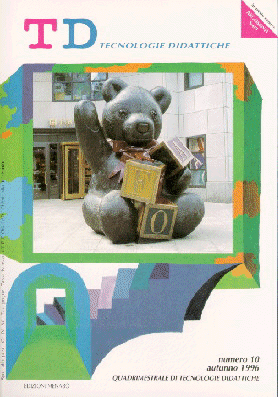Insegnamento e apprendimento in rete: la didattica per corrispondenza del XXI secolo?
Contenuto principale dell'articolo
Abstract
Dettagli dell'articolo
Gli autori che pubblicano su questa rivista accettano le seguenti condizioni:
- Gli autori mantengono i diritti sulla loro opera e cedono alla rivista il diritto di prima pubblicazione dell'opera, contemporaneamente licenziata sotto una Licenza Creative Commons CC BY 4.0 Attribution 4.0 International License.
- Gli autori possono aderire ad altri accordi di licenza non esclusiva per la distribuzione della versione dell'opera pubblicata (es. depositarla in un archivio istituzionale o pubblicarla in una monografia), a patto di indicare che la prima pubblicazione è avvenuta su questa rivista.
- Gli autori possono diffondere la loro opera online (es. in repository istituzionali o nel loro sito web) prima e durante il processo di submission, poiché può portare a scambi produttivi e aumentare le citazioni dell'opera pubblicata (Vedi The effect of Open Access).
Riferimenti bibliografici
Boot R., Hodgson V. (1988), Open Learning: philosophy or expediency?, Programmed Learning and Educational Technology, 25 3.
Davie L., (1992), Facilitation Techniques for the Online Tutor in Kaye A. R. (ed), Collaborative Learning Through Computer Conferencing, SpringerVerlag, Berlin.
Feenberg A. (1989), The Written World in Mason R. D. and Kaye A. R. (Eds), Mindweave Communication, Computers and Distance Education, Pergamon, Oxford.
Harasim L. (1989), Online Education: a new domain in Mason R. D. and Kaye A. R. (eds), Mindweave Communication, Computers and Distance Education, Pergamon, Oxford.
Kaye A. R. (1992), Collaborative Learning Through Computer Conferencing, Springer-Verlag, Berlin.
Mason R. D., Kaye A. R. (1989), Mindweave Communication, Computers and Distance Education, Pergamon, Oxford.
Mc Connell D. (1992), Computer Mediated Communication for Management Learning in Kaye A R (ed), Collaborative Learning through Computer Conferencing, SpringerVerlag, Berlin.
Rowntree D. (1985), Developing Courses for Students, Paul Chapman, London.
Soby M. (1992), Waiting for Electropolis in Kaye A R (ed), Collaborative Learning through Computer Conferencing, SpringerVerlag, Berlin.
TLO (1994), Teaching and Learning Online, a 3-month online course for teachers and trainers run twice a year by the Institute of Educational Technology, in the Open University.
Wegerif R. (1995), Collaborative Learning on TLO 94: creating an online community (CITE report number 212, Institute of Educational Technology, Open University, Milton Keynes).

